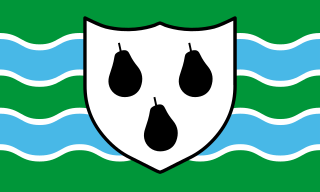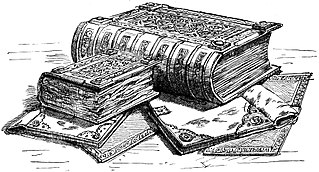
A village is a clustered human settlement or community, larger than a hamlet but smaller than a town, with a population ranging from a few hundred to a few thousand. Though villages are often located in rural areas, the term urban village is also applied to certain urban neighborhoods. Villages are normally permanent, with fixed dwellings; however, transient villages can occur. Further, the dwellings of a village are fairly close to one another, not scattered broadly over the landscape, as a dispersed settlement.

Clifton Hampden is a village and civil parish on the north bank of the River Thames, just over 3 miles (5 km) east of Abingdon in Oxfordshire. Since 1932 the civil parish has included the village of Burcot, 1 mile (1.6 km) east of Clifton Hampden. The 2011 Census recorded the parish population as 662.

Belbroughton is a village and civil parish in the Bromsgrove District of Worcestershire, England. According to the 2001 census it had a population of 2,380. It is about six miles north of Bromsgrove, six miles east of Kidderminster and four miles south of Stourbridge. The village of Clent is nearby.

Sandford-on-Thames is a village and Parish Council beside the River Thames in Oxfordshire just south of Oxford. The village is just west of the A4074 road between Oxford and Henley.

Culham was a rural district in Oxfordshire, England from 1894 to 1932. It was formed under the Local Government Act 1894 from the part of the Abingdon Rural Sanitary District in the administrative county of Oxfordshire. The remainder of the sanitary district, in the administrative county of Berkshire, became Abingdon Rural District. The rural district council continued to be based at Abingdon, holding meetings in the workhouse of the poor law union.

Iffley Lock is a lock on the River Thames in England near the village of Iffley, Oxfordshire. It is on the southern outskirts of Oxford. The original lock was built by the Oxford-Burcot Commission in 1631 and the Thames Navigation Commission replaced this in 1793. The lock has a set of rollers to allow punts and rowing boats to be moved between the water levels.
The Thames Navigation Commission managed the River Thames in southern England from 1751 to 1866. In particular, they were responsible for installing or renovating many of the locks on the river in the 18th and early 19th centuries
The Oxford-Burcot Commission was the first Commission concerned with the management of the River Thames, appointed by an Act of Parliament of 1605 by James I to make the stretch of river from Burcot to Oxford navigable. The Commission took responsibility for the management of the River Thames between Oxford and Burcot. It consisted of 18 members, including a representative each from Oxford city and from the University. However its work was irregular and by 1611 it had ceased altogether.

Abingdon Lock is a lock on the River Thames in England, less than 1 mile east and upstream of Abingdon, Oxfordshire, on the opposite bank of the river. It was originally built in 1790 by the Thames Navigation Commission.

Sandford Lock is a lock on the River Thames in England, situated at Sandford-on-Thames which is just South of Oxford. The first pound lock was built in 1631 by the Oxford-Burcot Commission although this has since been rebuilt. The lock has the deepest fall of all locks on the Thames at 8ft 9in (2.69m) and is connected to a large island which is one of three at this point.

Burcot is a hamlet in Oxfordshire, England on the left bank of the River Thames, in the civil parish of Clifton Hampden. Until 1932, it lay in the civil parish of Dorchester.

Andersey Island is a 273-acre (110.5 ha) area of flood-meadow and former flood-meadow south-east of Abingdon Bridge, Abingdon, Oxfordshire on the reach above Culham Lock in which parish it lies however maintaining close links with Abingdon by virtue of its current amenities. It is the second-largest island of the non-tidal course of the River Thames in England upstream of the Tideway — if disqualifying the villages of Dorney and Eton, Berkshire enclosed by the engineered Jubilee River. Andersey means Andrew's island after its chapel to St Andrew, demolished, built about 1050 CE.

The Swift Ditch is a backwater of the River Thames in England, which was formerly the primary navigation channel. With the main river, it creates the large island of Andersey Island near Abingdon, Oxfordshire.
Frederick William Rushbrooke was the founder of Halfords, one of the United Kingdom's largest chains of cycle shops.

North Hill is the second highest point of the range of Malvern Hills that runs about 13 kilometres (8.1 mi) north-south along the Herefordshire-Worcestershire border, although North Hill lies entirely within Worcestershire. It has an elevation of 397 metres (1,302 ft), making it the highest point of the Worcestershire Way.
Burchard Kranich was a mining engineer and physician who came to England from Germany. He was involved in mining ventures in Derbyshire and Cornwall, and in assaying the black ore, thought to be gold-bearing, brought back to England from Baffin Island by Martin Frobisher. He later practised as a physician in London, where he enjoyed a mixed reputation, and is said to have attended Elizabeth I when she contracted smallpox. He is alluded to in several literary works published during the reigns of Elizabeth I and James I.

Donald Gilbert (1900–1961), named Hubert Donald Macgeoch Gilbert at birth, was an English sculptor and modeller. He studied at prestigious art schools in England, Rome and Florence before beginning his career. He did works under his own name, such as commissions for the Adelphi building in London. He also collaborated with his father, Walter Gilbert, a sculptor at H.H. Martyn.
Mary Woodall also known as "Mighty Mary" (1901–1988) was a British art historian, museum director, and Thomas Gainsborough scholar.
















